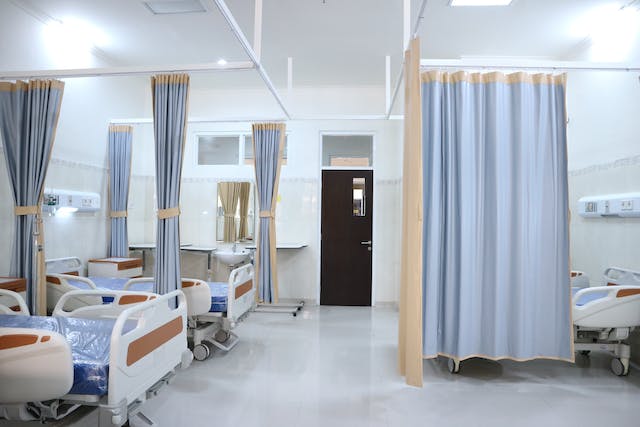Hospitals are changing the way they care for patients, focusing more on making patients comfortable and well. This new approach understands that getting better involves more than just medicine – it’s about both the body and the mind. Now, hospital beds, which used to be just a place to rest, are becoming important in promoting wellness and making healing a positive experience.
Ergonomic hospital beds – specially designed to make patients comfortable and functional. These beds do more than just provide support; they have lots of features that help with moving around, ease pain, and give patients a feeling of control. These beds are not just tools; they actively help in the healing process, making patients feel better and ensuring a more respectful healthcare journey. So, it’s not just about medical treatment anymore – it’s about creating a better experience for patients on their way to recovery.
Defining Ergonomic Hospital Beds
Ergonomics for hospital beds means designing them to fit the body well and be easy to use. Your home bed is comfy, right? Now, imagine it with extra features to help with health issues and make you heal better.
Here are some cool features of modern hospital beds:
- Adjustable Height: You can easily change the bed’s height for getting in, out, or talking to caregivers. This helps avoid back and leg strain, especially if you can’t move much.
- Head and Foot Elevation: Moving the head and foot parts helps with blood flow, breathing, and finding comfy positions. It also lets you sit up for reading or eating without trouble.
- Side Rails: These keep you safe and help when you’re getting in or out of bed. Some can even be adjusted or moved to let you do things on your own.
- Pressure-Reducing Mattresses: These special mattresses spread your weight evenly, preventing sore spots on your skin. This is super important for people who have to stay in bed a lot.
These are just a few examples, and beds can have different features based on what a patient needs. The main idea is to create a bed that fits the person and their condition. This helps them move on their own, reduces pain, and gives a feeling of control.
All of this makes healing better and faster. So, a good hospital bed isn’t just about being comfy; it’s about helping patients and making their journey to recovery easier.
Impact of Ergonomic Beds on Patient Outcomes
Ergonomic hospital beds aren’t just fancy—they help patients both physically and mentally.
Physical Health
- Preventing Sores: Regular beds can cause painful sores, but ergonomic beds with special mattresses stop that.
- Moving Easier: Adjustable beds and grab bars help patients get in and out by themselves, boosting their mood and recovery.
- Less Pain, Better Sleep: Adjustable beds ease pain, and comfy mattresses mean better sleep, important for healing.
Mental Well-being
- Feeling in Control: Patients can adjust their bed, giving them control and an active role in recovery.
- Less Stress and Anxiety: Ergonomic beds are comfy and reduce stress. Feeling safe helps patients stay calm and positive.
- Happier Patients: People using ergonomic beds are happier with their care, cooperate better with doctors, and may even get healthier.
With ergonomic beds caring for both body and mind, patients get better faster, feel happier, and have a better time in the hospital. It’s a win-win for everyone!
Case Studies and Examples
Aiding Elder Care
78-year-old Mary, recovering from a hip fracture, found the adjustable height and grab bars of her ergonomic bed invaluable. “Getting in and out of bed used to be terrifying,” she shares. “Now, I feel confident and safe, which helps me focus on getting stronger.”
Post-Surgical Recovery
John, a young athlete recovering from knee surgery, credits his ergonomic bed with speeding up his rehab. “The ability to elevate my leg and ice it easily made a huge difference,” he says. “I was much more comfortable and proactive in my recovery.”
Improved Mental Well-being
Sarah, suffering from chronic pain, found the adjustable features of her bed helped her manage anxiety and sleep better. “Having some control over my environment felt empowering,” she explains. “It made the whole hospital experience less stressful.”
Quotes from Medical Professionals
- “Ergonomic beds are game-changers for patient comfort and mobility,” says Lee, a geriatric specialist. “They significantly reduce risks like pressure ulcers and falls, leading to faster recoveries and happier patients.”
- “In my post-surgical patients, ergonomic beds allow for optimal positioning and pain management,” adds Jones, an orthopedic surgeon. “This translates to shorter hospital stays and better long-term outcomes.”
Addressing Concerns and Accessibility
Cost and Space
Ergonomic beds might seem expensive at first, but they save money in the long run. Studies prove they help avoid problems like sores, falls, and long hospital stays. Many hospitals rent these beds, so they’re easy to get without spending a lot upfront.
Getting Help
Some healthcare groups and charities can help people who need special beds but can’t afford them. Doctors and nurses can talk about how these beds are helpful, so more people know about them and can use them, especially those who need them.
Conclusion
Ergonomic hospital beds are like superheroes in making patients feel better. They help with moving, reduce pain, and give a feeling of control. Real stories from people and quotes from doctors show how these beds make a big difference.
Even though they may seem a bit pricey, studies say they save money in the long run and many hospitals rent them. Some groups and charities can help those who can’t afford these special beds. So, in the end, ergonomic beds bring smiles, faster healing, and a better time in the hospital for everyone!







